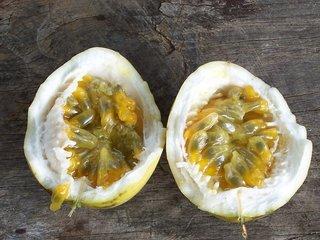
Passion fruit is a round or oval fruit with a tough, purple or yellow outer rind. The inside is filled with juicy, seed-filled pulp. Taste: The pulp is sweet-tart and aromatic, often described as a mix of citrus and tropical flavors. The seeds are edible and have a crunchy texture. Varieties: The two most common types are purple passion fruit (Passiflora edulis) and yellow passion fruit (Passiflora edulis f. flavicarpa).
Rich in vitamins A and C, which are important for skin health, immune function, and vision. High in dietary fiber, which aids in digestion and helps maintain a healthy digestive system. Contains powerful antioxidants that help protect the body against free radicals and oxidative stress.
Provides essential minerals such as potassium, magnesium, and iron, contributing to heart health and energy production. Often eaten fresh by scooping out the pulp and seeds.
Juices and Beverages: Used to make juices, smoothies, cocktails, and other refreshing drinks.
Desserts: Commonly used in desserts like tarts, mousses, ice creams, and sauces.
Savory Dishes: Adds a unique flavor to salad dressings, marinades, and sauces for meats and seafood.
Traditional and Cultural Uses: Traditionally used in various cultures for its calming and sedative properties, often in the form of teas or extracts.
Symbolism: In some cultures, the passion fruit flower is a symbol of the Passion of Christ, reflecting its religious significance. Overall, passion fruit is not only a delicious and versatile fruit but also a nutritious addition to a healthy diet, providing numerous health benefits and culinary possibilities.
